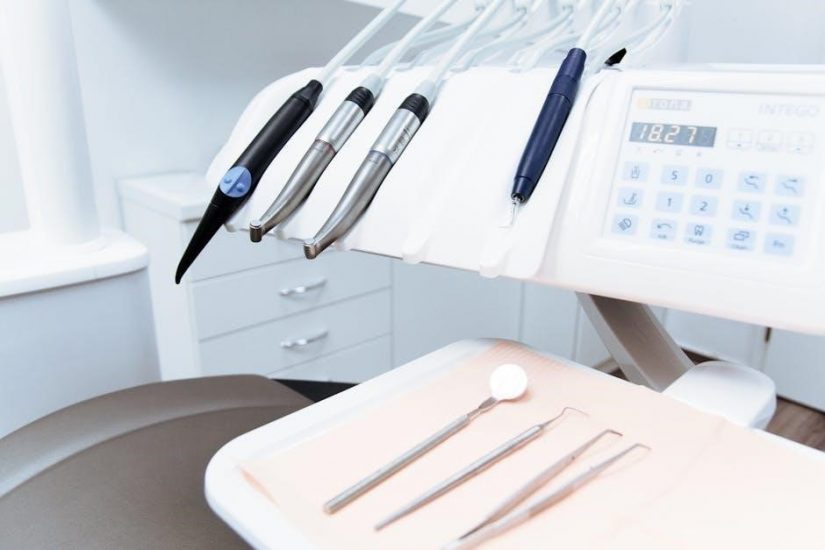A comprehensive guide covering dental fundamentals, clinical procedures, and diagnostic techniques, serving as an essential resource for professionals and students, supporting evidence-based practices and lifelong learning in dentistry.
Overview of Dental Handbook PDF
The Dental Handbook PDF serves as a comprehensive guide, covering fundamental sciences, clinical procedures, diagnostic techniques, and management strategies. It is tailored to support dental professionals, offering evidence-based practices and updated trends in dentistry. The handbook emphasizes prevention, reflecting modern approaches in pediatric and general dental care. It also provides resources for exam preparation and includes case studies, making it a valuable tool for both professionals and students. With detailed sections on various dental specialties, the handbook ensures a holistic understanding of dental medicine, supporting lifelong learning and professional development in the field.
Importance of Dental Handbook for Professionals
The Dental Handbook PDF is an essential resource for dental professionals, offering evidence-based practices and updated trends in dentistry. It provides comprehensive insights into clinical procedures, diagnostic techniques, and management strategies, enabling professionals to deliver high-quality care. The handbook serves as a reference for standardized dental practices, ensuring consistency and accuracy in treatment. It also supports continuing education, helping professionals stay informed about advancements in the field. By addressing both fundamental and specialized aspects of dentistry, the handbook is a vital tool for enhancing professional competence and fostering improved patient outcomes in daily practice.
Key Features of a Comprehensive Dental Handbook
A comprehensive dental handbook PDF typically includes detailed procedure guidelines, diagnostic criteria, and treatment protocols. It features high-quality images, diagrams, and illustrations to enhance understanding. The handbook covers both basic and advanced dental practices, ensuring relevance for all skill levels. It also includes sections on patient assessment, case management, and ethical considerations. Quick reference charts, dosages, and contraindications are often highlighted for easy access. The content is evidence-based, reflecting current standards and research. These features make the dental handbook an indispensable resource for education, clinical decision-making, and professional development in dentistry.
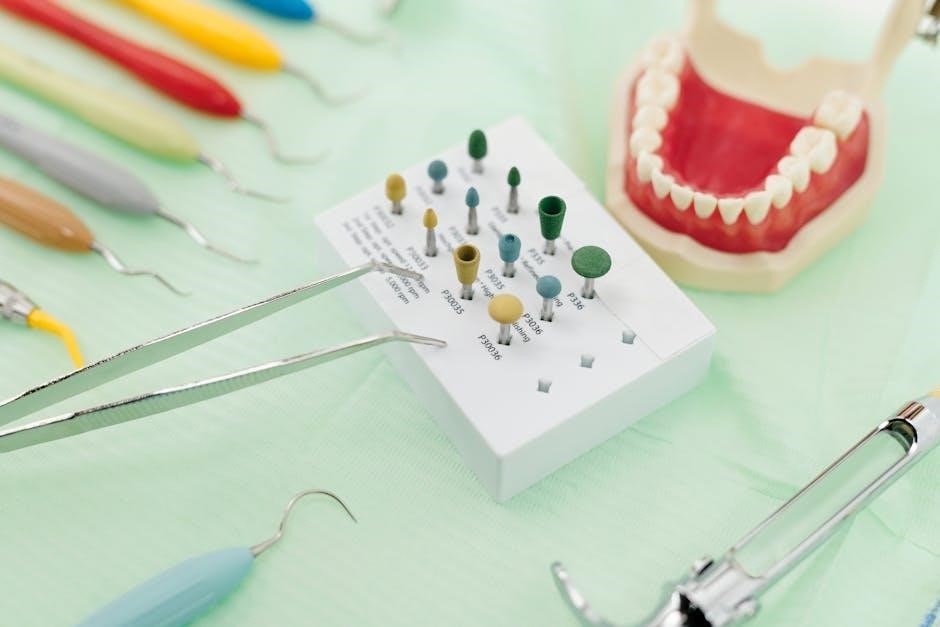
Fundamentals of Dental Care
Fundamentals of dental care encompass essential practices for maintaining oral health, including hygiene, preventive measures, and patient education. These principles form the foundation for all dental treatments.
Basic Dental Sciences and Terminology
Basic dental sciences and terminology provide the foundation for understanding oral health and dental procedures. This section introduces key concepts such as dental anatomy, histology, and embryology, explaining the structure and development of teeth and surrounding tissues. Essential terminology is defined to ensure clarity in communication among professionals and patients. Topics include classifications of teeth, types of dental tissues, and fundamental biological processes. This knowledge is crucial for diagnosing and treating dental conditions effectively, forming the basis of all dental education and practice.
Common Dental Procedures and Techniques
Common dental procedures and techniques are essential for maintaining oral health and addressing various dental issues. These include routine cleanings, fillings, extractions, and crowns, which are fundamental for restoring teeth. Techniques like root canals and dental implants are used to treat advanced decay and missing teeth. Additionally, cosmetic procedures such as veneers and teeth whitening enhance aesthetic appeal. Preventive measures like fluoride treatments and sealants are also highlighted. Understanding these procedures and techniques is vital for dental professionals to provide effective care and address patient needs comprehensively. This section provides clear insights into the practical aspects of dental practice.
Understanding Dental Anatomy and Physiology
Understanding dental anatomy and physiology is foundational for effective dental care. It involves the study of tooth structure, including enamel, dentin, and pulp, as well as surrounding tissues like gums and bones. The temporomandibular joint (TMJ) plays a crucial role in jaw movement and function. Knowledge of dental anatomy helps professionals diagnose issues accurately and perform treatments effectively. Physiology explains how teeth and tissues function, including nerve responses and blood supply. This section provides detailed insights into the intricacies of dental structures and their interconnections, essential for both professionals and students seeking to master dental care principles.
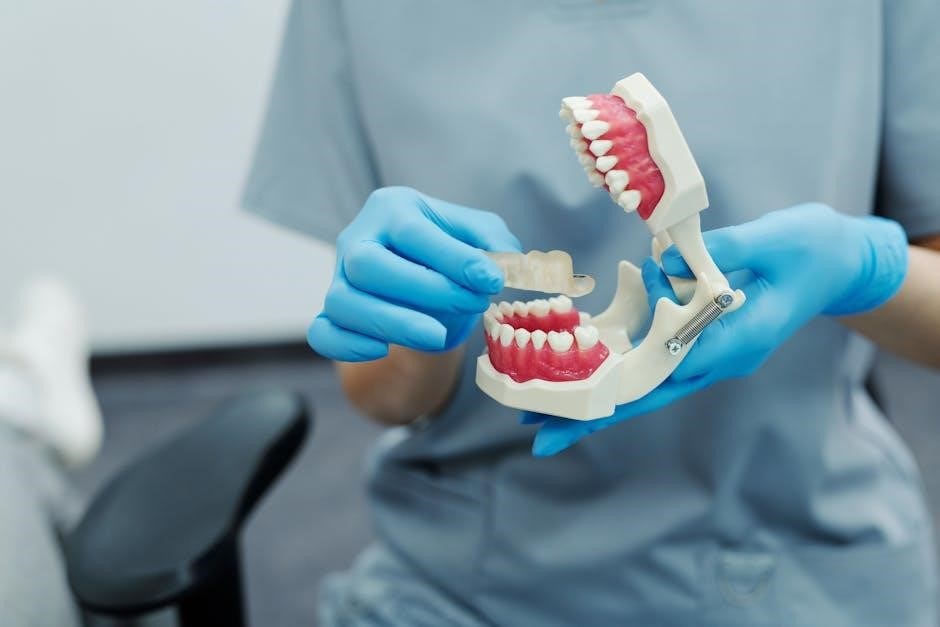
Dental Instruments and Equipment
Dental instruments and equipment are essential tools for diagnosing, treating, and preventing oral health issues. They range from basic handheld instruments to advanced technological devices, ensuring precise and efficient dental care. Proper selection, maintenance, and sterilization of these tools are critical for patient safety and effective treatment outcomes. This section provides an overview of the fundamental instruments and equipment used in modern dentistry, highlighting their roles and importance in daily practice.
Essential Dental Instruments for Daily Practice
Educational research highlights essential dental instruments for daily practice, including mirrors, probes, scalers, and drills. These tools are vital for examining, diagnosing, and treating patients effectively. Dental mirrors provide clear visibility, while probes measure pocket depths. Scalpels are used for incisions, and drills prepare teeth for restorations. Proper instrument organization enhances efficiency, ensuring quick access during procedures. Regular sterilization and maintenance prolong their lifespan. These instruments form the cornerstone of dental care, enabling precise and effective treatment. Their versatility and durability make them indispensable in modern dental practice, as outlined in the dental handbook PDF.
Advanced Dental Equipment and Their Uses
Advanced dental equipment enhances precision and efficiency in modern practice. Cone beam CT scanners provide detailed 3D imaging for complex diagnoses. CAD/CAM systems fabricate custom restorations like crowns and implants. Laser dentistry tools minimize invasive procedures, reducing recovery times. Digital impression systems capture accurate tooth molds, improving prosthetics. Intraoral cameras offer real-time patient education, while ultrasonic scalers enhance plaque removal. These technologies integrate seamlessly, optimizing treatment outcomes. Regular updates in dental handbooks ensure professionals stay informed about the latest advancements, fostering continuous improvement in patient care and operational efficiency.
Maintenance and Sterilization of Dental Tools
Proper maintenance and sterilization of dental tools are critical for infection control. Tools must be thoroughly cleaned with detergent before sterilization. Autoclaving is the most common method, using high-pressure steam to kill pathogens. Chemical sterilization is an alternative for heat-sensitive instruments. Disinfection is used for non-invasive tools that cannot be sterilized. Regular maintenance ensures equipment longevity and functionality. Storage in sealed pouches or containers prevents contamination. Compliance with infection control standards is essential to protect both patients and dental professionals. Proper protocols must be followed diligently to maintain a safe and hygienic dental environment.

Dental Radiography and Imaging
Dental radiography and imaging are essential for diagnosing oral health issues. They include intraoral and extraoral X-rays, providing detailed views of teeth and surrounding structures. Modern imaging enhances accuracy, aiding in early detection and treatment planning for various dental conditions.
Types of Dental Radiographic Films
Dental radiographic films are categorized into intraoral and extraoral types. Intraoral films, such as periapical and bitewing, capture detailed images of individual teeth and surrounding structures. Extraoral films, like panoramic and cephalometric, provide wider views for comprehensive diagnoses. Each type serves specific purposes, aiding in the detection of decay, fractures, and anatomical abnormalities. Modern advancements have introduced digital alternatives, reducing radiation exposure and enhancing image quality. Understanding these film types is crucial for accurate diagnoses and effective treatment planning in dental care.
Digital Imaging in Modern Dentistry
Digital imaging revolutionizes dental diagnostics by offering high-resolution images with reduced radiation exposure. Technologies like intraoral scanners and cone-beam computed tomography (CBCT) provide detailed 3D views, enhancing diagnostic accuracy. Digital X-rays enable instant image processing, storage, and sharing, improving patient care coordination. Software tools allow for measurements, annotations, and simulations, aiding in treatment planning. Digital systems also reduce environmental impact by eliminating chemical processing. Integration with electronic health records streamlines workflows, making digital imaging indispensable in modern dental practice for efficient, precise, and patient-centric care.
Interpreting Dental X-rays and Scans
Interpreting dental X-rays and scans requires a systematic approach to identify anatomical structures and detect abnormalities; Radiographs help diagnose conditions like tooth decay, periodontal disease, and bone loss. Key steps include evaluating the clarity of images, assessing the integrity of dental structures, and noting any pathological changes. Advanced imaging techniques, such as CBCT scans, provide 3D views for complex diagnoses. Accurate interpretation ensures timely and appropriate treatment, making it a critical skill for dental professionals to master. Proper training and experience are essential for reliable and effective analysis of dental radiographs and scans in clinical practice.

Specialized Dental Fields
Specialized dental fields encompass orthodontics, periodontology, and prosthodontics, addressing diverse patient needs and ensuring optimal oral health and aesthetics through advanced treatments and personalized care approaches.
Orthodontics and Its Role in Dental Care
Orthodontics focuses on correcting misaligned teeth and jaws to enhance oral function, aesthetics, and overall patient confidence. Techniques like braces, clear aligners, and retainers address overcrowding, overbites, and underbites. Early intervention in children can guide proper jaw development, while adult treatments improve long-term oral health. Orthodontic care reduces risks of tooth wear, gum disease, and chewing difficulties. Proper alignment also aids in better cleaning and maintenance of teeth. As a specialized field, orthodontics plays a vital role in comprehensive dental care, ensuring patients achieve both functional and cosmetic benefits for a lifetime of healthy, aligned smiles.
Periodontology and Gum Disease Treatment
Periodontology focuses on the diagnosis, treatment, and prevention of diseases affecting the gums and supporting structures of the teeth. Gum disease, also known as periodontal disease, progresses from mild gingivitis to severe periodontitis, leading to tooth loss if untreated. Causes include poor oral hygiene, plaque buildup, and risk factors like smoking or diabetes. Symptoms include bleeding gums, bad breath, and loose teeth. Treatments range from non-surgical scaling and root planing to surgical interventions like gum grafting. Early detection and maintenance are crucial for managing periodontal health and preventing complications, ensuring long-term dental stability and overall well-being.
Prosthodontics and Dental Restorations
Prosthodontics specializes in the restoration and replacement of damaged or missing teeth to enhance functionality and aesthetics. Common treatments include crowns, bridges, dentures, and dental implants. These restorations address tooth loss due to decay, trauma, or disease. Modern advancements, such as CAD/CAM technology and 3D printing, allow for precise and natural-looking results. Prosthodontists also focus on occlusion and bite alignment to ensure optimal chewing and speaking ability. Regular maintenance and follow-ups are essential for the longevity of dental restorations, contributing to improved oral health and patient satisfaction.

Pediatric and Geriatric Dentistry
Pediatric dentistry focuses on children’s dental health, addressing growth, development, and education. Geriatric dentistry manages age-related oral issues, ensuring comfort and functionality for elderly patients.
Child Dental Care and Developmental Aspects
Child dental care emphasizes early interventions to ensure healthy oral development. Regular check-ups, fluoride treatments, and sealants are crucial for preventing decay. Developmental aspects include monitoring teething, thumb-sucking habits, and tooth alignment. Education on proper hygiene practices and diet is essential for parents. Understanding growth patterns helps dentists address issues like overcrowding or enamel defects early. Timely interventions can prevent long-term complications, fostering a lifetime of oral health. This section of the dental handbook provides practical guidance for parents and professionals to support children’s dental well-being from infancy through adolescence.
Geriatric Dentistry and Aging Patients
Geriatric dentistry focuses on addressing oral health challenges in aging patients. Tooth decay, gum disease, and tooth wear are common due to receding gums and dry mouth. Dental care for seniors often involves managing conditions like denture fit, root caries, and periodontal disease. Medications can cause dry mouth, increasing decay risk. Regular check-ups and tailored treatments are essential for maintaining oral health. This section of the dental handbook highlights strategies for caring for aging patients, emphasizing the importance of preventive measures and adaptive techniques to ensure comfort and functionality throughout life.
Special Needs Dentistry and Challenges
Special needs dentistry addresses the unique oral health challenges of patients with physical, emotional, or cognitive disabilities. Conditions like autism, Down syndrome, and cerebral palsy require tailored approaches. Communication is key, using visual aids and behavioral techniques to build trust. Dental teams must adapt procedures to accommodate sensory sensitivities or mobility issues. Sedation or general anesthesia may be necessary for complex cases. This section emphasizes the importance of patience, understanding, and collaboration to provide compassionate care, ensuring access to essential dental services for all patients, regardless of their abilities.
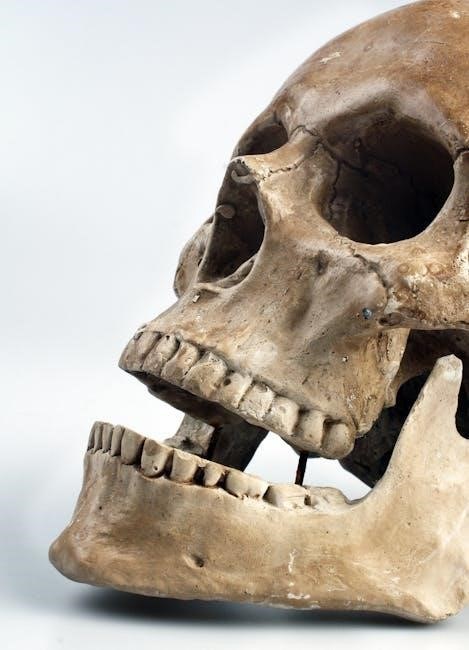
Dental Emergency Management
Effective dental emergency management ensures timely care, preventing minor issues from escalating. It requires quick decision-making and appropriate interventions, addressing challenges like severe pain or trauma.
Common Dental Emergencies and First Aid
Common dental emergencies include toothaches, broken teeth, lost fillings, or knocked-out teeth. First aid measures like rinsing with warm water, applying ice, or using temporary fillers can alleviate symptoms. For a knocked-out tooth, gently rinsing and reimplanting it or storing it in milk can improve survival chances. Severe pain, swelling, or bleeding require immediate professional attention. Proper first aid can prevent complications and improve treatment outcomes, making it essential for dental professionals to guide patients effectively in such situations. A dental handbook provides clear, step-by-step instructions for managing these emergencies confidently and efficiently.
Emergency Procedures in Dental Practice
Dental practices must be prepared for emergencies like medical crises or traumatic injuries. Key procedures include airway management, bleeding control, and cardiac arrest response. Staff should be trained in CPR and the use of emergency kits. For severe trauma, stabilizing the patient and preventing further injury is critical. Clear communication and quick decision-making are vital to ensure patient safety. Regular drills and updated protocols help maintain readiness; A well-organized emergency plan minimizes risks and improves outcomes, ensuring prompt and effective care during critical situations. Proper documentation of incidents is also essential for legal and quality improvement purposes.
Pain Management and Anesthesia in Emergencies
Pain management and anesthesia are critical in dental emergencies to alleviate patient discomfort and facilitate treatment. Local anesthetics, such as lidocaine or articaine, are commonly used to numb the affected area. In severe cases, conscious sedation may be employed to reduce anxiety and pain. Rapid assessment of the patient’s medical history is essential to avoid complications. Emergency protocols should include guidelines for administering analgesics and anesthetics safely. Proper dosing and monitoring ensure patient safety and effective pain relief. Adhering to legal and professional standards is paramount when using anesthetic agents in urgent care situations to optimize outcomes and minimize risks. This ensures ethical and efficient care delivery.

Preventive Dentistry and Oral Hygiene
Preventive dentistry focuses on maintaining oral health through regular check-ups, good hygiene practices, and fluoride use. It emphasizes early detection and treatment to avoid complex issues, promoting lifelong healthy teeth and gums while reducing the need for invasive procedures.
Fluoride Therapy and Its Benefits
Fluoride therapy is a proven method to strengthen tooth enamel, preventing decay and sensitivity. It can be applied topically or ingested, promoting mineralization and reversing early-stage cavities. Community water fluoridation has significantly reduced tooth decay rates. Professional treatments, like varnishes, offer high concentrations for at-risk patients. Fluoride therapy is especially beneficial for children, helping develop decay-resistant teeth. Regular use enhances oral health, making teeth more resistant to acid attacks from plaque and bacteria. Its effectiveness makes it a cornerstone in preventive dentistry, widely recommended by dental professionals for long-term oral health benefits.
Oral Hygiene Practices for Different Age Groups
Oral hygiene practices vary across age groups to address specific needs. Infants require gentle cleaning with soft cloths, while children benefit from supervised brushing with fluoride toothpaste. Teenagers should focus on proper brushing technique and flossing, especially with orthodontic appliances. Adults need to prioritize plaque control and prevent periodontal disease. Seniors often require gentle cleaning due to sensitive gums and may need assistance with denture care. Tailoring hygiene practices to each life stage ensures optimal oral health and prevents age-related dental issues. Regular dental check-ups are essential to adjust routines and address unique challenges at every stage of life.
The Role of Sealants in Preventing Tooth Decay
Dental sealants play a crucial role in preventing tooth decay by creating a protective barrier over tooth surfaces. Typically applied to molars, sealants block bacteria and acids from reaching enamel, reducing the risk of cavities. They are most effective when applied to newly erupted teeth in children, though adults can benefit too. The procedure is simple, painless, and safe, offering long-lasting protection. Regular check-ups ensure sealants remain intact, making them a valuable preventive measure against tooth decay and promoting overall oral health.
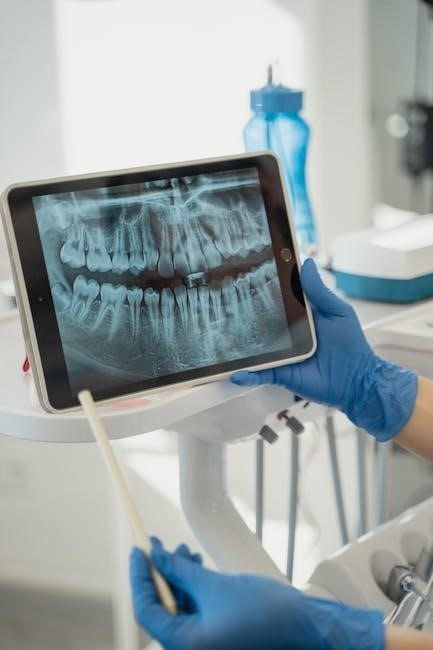
Dental Handbook as a Study Resource
A dental handbook serves as a complete study guide, aiding students and professionals with structured content, visual aids, and key concept highlights to excel in academics and professional practice.
Using Dental Handbook for Exam Preparation
A dental handbook is an indispensable tool for exam preparation, offering concise notes, diagrams, and practice questions. It covers key topics like anatomy, procedures, and diagnostics, aligning with exam syllabi. Students can focus on weak areas using detailed chapter summaries and mock tests. Visual aids and real-life examples enhance understanding of complex concepts. The handbook also provides time management tips and strategies for tackling multiple-choice questions. Regular use ensures familiarity with exam formats and boosts confidence. It’s a comprehensive resource that bridges theory and practice, helping aspirants excel in both academic and professional assessments with ease and precision.
Study Tips and Resources for Dental Students
Dental students can enhance their learning by utilizing the dental handbook PDF effectively. Active recall and spaced repetition are powerful techniques to retain complex concepts. Create flashcards from key terms and procedures. Use the handbook’s charts and diagrams to visualize anatomical structures and processes. Supplement your studies with online resources, such as anatomy apps, webinars, and forums. Stay organized by highlighting and annotating important sections. Practice case-based learning to apply theoretical knowledge. Join study groups to discuss challenging topics. Regularly review and test yourself using the handbook’s case studies and practical examples.
Case Studies and Practical Examples in Dental Handbook
The dental handbook PDF includes real-world case studies and practical examples to enhance learning and application. These scenarios cover common dental issues, such as tooth decay, gum disease, and orthodontic misalignment, providing step-by-step solutions. Practical examples demonstrate techniques like cavity preparation, implant placement, and smile design. Case studies highlight both successful outcomes and challenges, offering insights into decision-making and problem-solving. This approach helps practitioners and students connect theoretical knowledge with clinical practice, improving diagnostic and treatment skills. By analyzing these examples, readers can better understand patient care and refine their expertise in diverse dental situations.
Creating a Dental Handbook PDF
Creating a dental handbook PDF involves compiling essential dental information, designing layouts for clarity, and ensuring accessibility for professionals and students. Utilize tools like Canva or Adobe Acrobat for professional formatting, and organize content logically to enhance readability and usability.
Designing a Dental Handbook for Clarity
Designing a dental handbook for clarity involves organizing content logically and presenting it in an easy-to-understand format. Use clear headings, subheadings, and bullet points to break down complex information. Incorporate high-quality images, diagrams, and infographics to visually explain procedures and concepts; Ensure consistent formatting, such as font styles and spacing, to maintain readability. Use color coding or highlights for key terms or steps to draw attention. Prioritize white space to avoid overwhelming the reader. Finally, ensure the handbook is accessible on multiple devices by optimizing the PDF for both desktop and mobile viewing. Clarity enhances usability for dental professionals and students.
Tools for Creating and Editing PDF Handbooks
Creating and editing a dental handbook PDF requires the right tools to ensure clarity and professionalism. Adobe Acrobat is a leading choice for designing and editing PDFs, offering advanced features like text formatting and image insertion. Canva is another popular option, providing templates and a user-friendly interface for visually appealing layouts. For collaboration, Google Docs and Microsoft Word allow real-time edits before converting to PDF. Specialized tools like PDFelement and Smallpdf simplify tasks like merging files, adding annotations, and securing documents. These tools help dental professionals create and refine handbooks efficiently, ensuring they are both informative and accessible.
Best Practices for Organizing Dental Handbook Content
Organizing a dental handbook PDF requires a structured approach to ensure clarity and accessibility. Start by categorizing content into logical sections, such as dental specialties or procedures. Use clear headings and subheadings to guide readers. Incorporate visual aids like diagrams and images to enhance understanding. Include an index and cross-references for easy navigation. Prioritize concise language and bullet points for complex information. Regularly update the content to reflect current practices and research. Finally, ensure the PDF is searchable and includes bookmarks for quick access. This systematic organization makes the handbook a valuable resource for both professionals and students.

Future of Dental Handbooks
The future of dental handbooks lies in digital innovation, offering accessible, interactive, and regularly updated resources for professionals and students. Digital formats enhance learning and practical application.
Integration of AI and advanced technologies will revolutionize dental handbooks, providing personalized learning experiences and real-time diagnostic tools, making them indispensable in modern dental education and practice.
Evolving content and formats will ensure dental handbooks remain relevant, incorporating multimedia, case studies, and evidence-based practices to meet the changing needs of the dental community.
Digital Trends in Dental Education and Practice
Digital trends are revolutionizing dental education and practice, offering innovative tools for learning and patient care. Virtual reality (VR) and augmented reality (AR) are enhancing training simulations and treatment planning. Dental Handbook PDF resources are increasingly incorporating interactive 3D models and videos to improve understanding of complex procedures. Tele dentistry platforms enable remote consultations, expanding access to care. AI-driven diagnostic tools assist in identifying conditions like caries and gum disease more accurately. These advancements not only modernize dental education but also streamline clinical workflows, ensuring better outcomes for patients. The integration of digital technologies is transforming dentistry into a more efficient and patient-centric field.
Integration of AI and Technology in Dental Handbooks
The integration of AI and technology in dental handbooks is revolutionizing dental education and practice. AI-powered tools now enable interactive simulations, allowing professionals to explore complex procedures virtually. Machine learning algorithms can analyze patient data, providing personalized treatment recommendations. Advanced search functions and voice-activated navigation make accessing information faster. Real-time updates ensure that handbooks remain current with the latest research and guidelines. Cloud-based platforms allow seamless collaboration between professionals. AI-driven diagnostic tools, such as automated X-ray analysis, enhance accuracy and efficiency. These innovations are transforming dental handbooks into dynamic, intelligent resources, bridging the gap between theory and practice.
Evolution of Dental Handbook Content and Format
The dental handbook has transformed significantly over the years, adapting to advancements in dentistry and educational needs. Traditionally, handbooks were print-based, focusing on basic procedures and terminology. Modern versions incorporate digital formats, offering multimedia content like images, videos, and interactive diagrams. Content now emphasizes evidence-based practices, patient-centered care, and interdisciplinary approaches. The shift to customizable digital PDFs allows for regular updates, ensuring professionals and students access the latest techniques and research. This evolution enhances learning and practical application, making dental handbooks indispensable tools for modern dental education and clinical practice.
